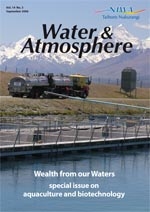PDF of this article (284 KB)






Ever since people first placed structures in the sea, there has been an ongoing battle to stop stuff growing on them. Craig Depree explains how NIWA is working with industry partners to solve the problem of fouling.
Unwanted organisms that stick to objects underwater are collectively referred to as ‘fouling’. They include microfoulers, like microscopic plants and bacteria, through to macrofoulers, such as barnacles, sea squirts, sponges, and seaweeds. Globally, billions of dollars are spent annually to control fouling on a variety of objects that are placed in the sea. Fouling creates expensive problems for shipping through increased drag and fuel consumption; seawater intake pipes suffer from reduced flows; and oil platforms and mooring systems all face major problems with increased abrasion and corrosion and decreased buoyancy. Fouling is also a headache for most types of aquaculture. The fouling usually competes for space and food with the cultured organisms, restricts water flow through nets and cage structures leading to accumulation of waste products, and frequently provides a safe haven for pests and diseases from which to attack the cultured organisms. For example, poor quality pearls often result from excessive handling by workers removing fouling from the oysters’ shells.
Conventional solutions
The basic way to deter underwater fouling on painted structures is with broad-spectrum biocides in paints; these usually rely on the toxic biocide being available or released from the surface of the paint. One of the most popular biocides was tributyltin (TBT), which kills organisms before, or soon after, they settle on a treated surface. However, TBT was found to be severely contaminating many estuaries and bays, causing deformities and the disappearance of some organisms. Consequently, the application of TBT to boats less than 25 m long was banned in the late 1980s, and a complete ban is set for 2008. TBT has largely been replaced in antifouling paints by mixtures of new types of biocides, including copper-based compounds. However, many of these new biocides are now also being banned because of their environmental side effects, and there are growing concerns about the long-term environmental effects of copper-based compounds. This highlights an urgent need to find alternative antifoulants with much better environmental performance.
Natural solutions
Many seaweeds and bottom-dwelling sea creatures, such as sponges and sea squirts, remain largely free of fouling, presumably by producing natural chemical defences. These organisms may be the source of antifouling compounds that discourage fouling larvae and spores from settling via non-toxic mechanisms. This is in contrast to conventional biocides that rely on toxicity and can harm non-target marine life. The goal of NIWA’s antifouling research is to use these natural antifouling defences and incorporate their chemistry into novel antifouling products.
NIWA’s antifouling research
For more than two years, NIWA has been identifying seaweeds, sea sponges, sea squirts, and sea laces that have natural antifouling properties that could be incorporated into a novel antifouling product. To do this, we identify marine organisms which are naturally free of fouling and take chemical extracts from samples. Then we test the antifouling effectiveness of the extracts against cultures of important fouling organisms, such as microalgae, bryozoans, and seaweeds. We have identified more than half a dozen extracts as having a potent antifouling effect against all the different types of nuisance fouling organisms we’ve tested in the laboratory. Then Scion Ltd, our research partner, attempts to incorporate derivatives of these extracts into paint and plastics in a manner that retains their antifouling activity. These new products are then laboratory and field-tested. Initial work by Scion has focused on developing a system for readily incorporating existing commercial biocides with known activity into paint and plastic formulations. This system acts as a model method for incorporating the natural antifoulants isolated from marine organisms by NIWA.
From the lab to the field
We’re testing the effectiveness of new products from the research with industry partners Quality Equipment Ltd, a major New Zealand manufacturer and exporter of rope for aquaculture, and Altex Coatings Ltd, the largest antifouling paint manufacturer in New Zealand. Our starting plastic formulations are based on the plastics used by Quality Equipment, and the research and development laboratory at Altex Coatings is supplying special antifouling paint formulations. Close industry involvement at the research stage ensures that local industry can take up the new technologies identified from the research.
Two rafts floating in Wellington Harbour at NIWA’s Mahanga Bay aquaculture facility are used for testing our antifouling formulations in the field. Researchers work closely with Altex Coatings staff to ensure the field-testing programme yields results that are consistent with industry requirements.
We apply the plastic formulations and paint samples to fibreglass rods and attached them to the sides of floating rafts, from the waterline down to almost a metre depth. These field trials have been used to measure the effectiveness of different model plastic and paint formulations using commercial biocides, compared to controls with no biocides. By field testing throughout the year, we are able to determine the most important fouling species and the seasonal fluctuations in fouling. Against this strong background information, laboratory and field testing of natural-product antifoulants will take place over the next year and will, we hope, result in valuable novel antifouling products for New Zealand.
Foul play
- Fouling is a persistent and costly problem for underwater structures.
- Biocides used in the past to prevent fouling have bad effects on the environment and many have been banned.
- NIWA is identifying natural antifouling chemicals produced by sea creatures and working with manufacturers to put these chemicals into commercial paints and plastics.
Dr Craig Depree is an organic chemist working at NIWA in Hamilton. Contact Craig at [email protected].
Teachers’ resource for NCEA AS: Biology 90718 (3.6), 90769 (2.2), 90168 (1.8), Level 3 US6355, Level 2 US6310, US6298, Level 1 US18978 Science Level 2 US6352 See other curriculum connections at www.niwa.co.nz/pubs/wa/resources
